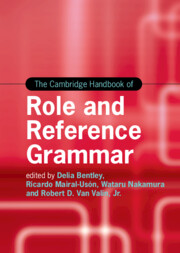Book contents
- The Cambridge Handbook of Role and Reference Grammar
- Cambridge Handbooks in Language and Linguistics
- The Cambridge Handbook of Role and Reference Grammar
- Copyright page
- Dedication
- Contents
- Figures
- Tables
- Contributors
- Pedagogical Guide to The Cambridge Handbook of Role and Reference Grammar
- Introduction
- Part One Overview
- Part Two Topics in RRG: Simple Sentences
- 2 Lexical and Grammatical Categories in RRG
- 3 A Conceptually Oriented Approach to Semantic Composition in RRG
- 4 Semantic Macroroles
- 5 Grammatical Relations
- 6 Argument Structure Alternations
- 7 Case Assignment
- 8 Morphology in RRG
- 9 Adverbs, Mimetics and Ideophones
- 10 Adposition Assignment and Adpositional Phrase Types in RRG
- 11 The RRG Approach to Information Structure
- 12 Information Structure and Argument Linking
- Part Three Topics in RRG: Complex Sentences
- Part Four Applications of RRG
- Part Five Grammatical Sketches
- Index
- References
3 - A Conceptually Oriented Approach to Semantic Composition in RRG
from Part Two - Topics in RRG: Simple Sentences
Published online by Cambridge University Press: 08 June 2023
- The Cambridge Handbook of Role and Reference Grammar
- Cambridge Handbooks in Language and Linguistics
- The Cambridge Handbook of Role and Reference Grammar
- Copyright page
- Dedication
- Contents
- Figures
- Tables
- Contributors
- Pedagogical Guide to The Cambridge Handbook of Role and Reference Grammar
- Introduction
- Part One Overview
- Part Two Topics in RRG: Simple Sentences
- 2 Lexical and Grammatical Categories in RRG
- 3 A Conceptually Oriented Approach to Semantic Composition in RRG
- 4 Semantic Macroroles
- 5 Grammatical Relations
- 6 Argument Structure Alternations
- 7 Case Assignment
- 8 Morphology in RRG
- 9 Adverbs, Mimetics and Ideophones
- 10 Adposition Assignment and Adpositional Phrase Types in RRG
- 11 The RRG Approach to Information Structure
- 12 Information Structure and Argument Linking
- Part Three Topics in RRG: Complex Sentences
- Part Four Applications of RRG
- Part Five Grammatical Sketches
- Index
- References
Summary
One of the major concerns of Role and Reference Grammar (RRG) has always been the development of a theory of semantic composition for both state and activity predicates. Over the last thirty years, there have been a variety of proposals aimed at the formulation of a semantic representation system that accounts for the interface between syntax and semantics. Proposals to enrich the RRG semantic representation system involve notations such as the use of internal variables, lexical functions and qualia structure, among others, in an effort to link syntax to conceptual or semantic meaning. Nevertheless, another solution could lie in a more ontologically oriented model of semantic representation that provides a conceptual framework for the formalization of meaning construction. This chapter outlines and describes a semantic representation system in the form of conceptual logical structures (CLSs), based on the FunGramKB ontology.
- Type
- Chapter
- Information
- The Cambridge Handbook of Role and Reference Grammar , pp. 218 - 241Publisher: Cambridge University PressPrint publication year: 2023



